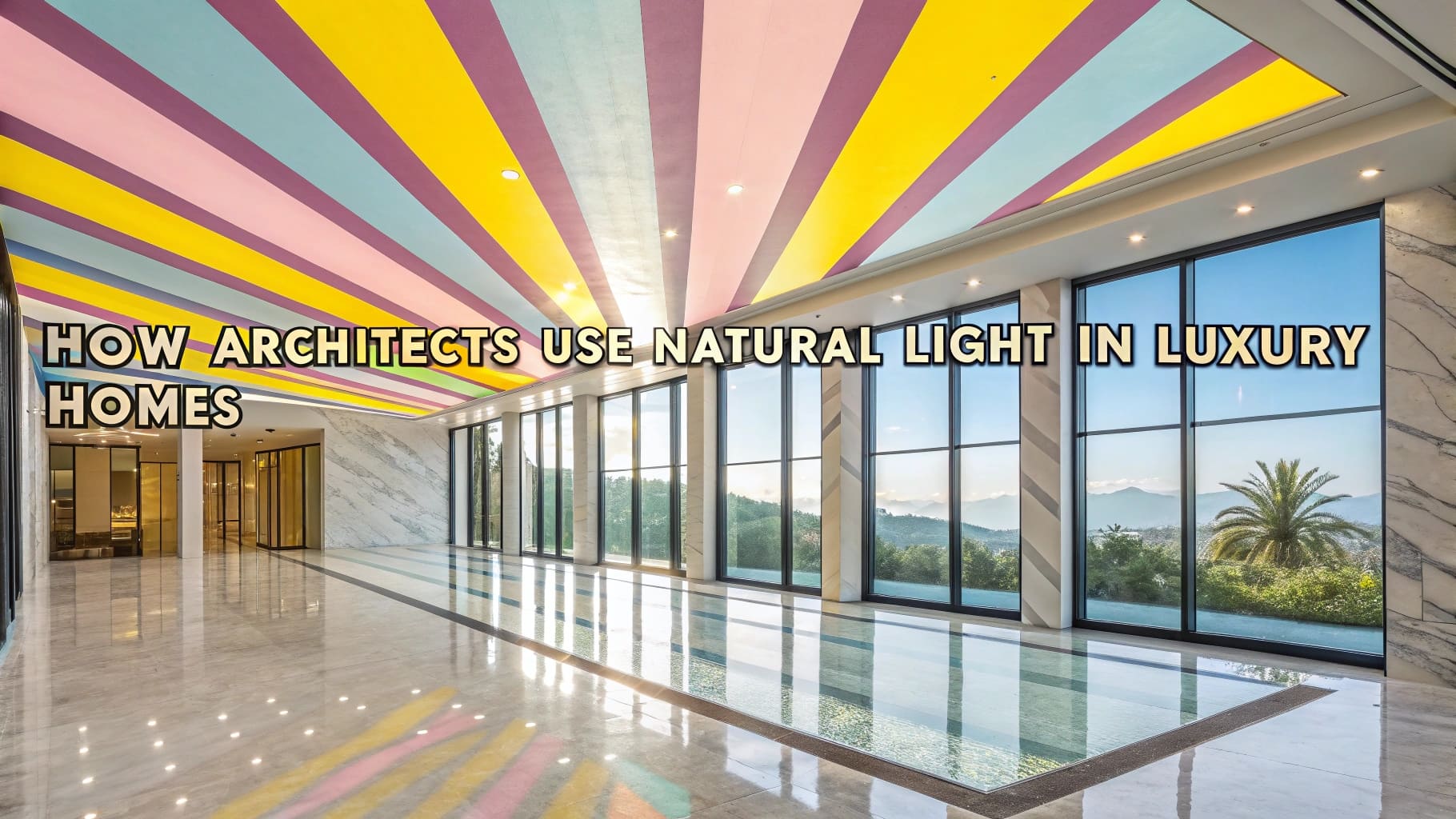Natural light plays a pivotal role in the ambiance and overall appeal of luxury homes. It is not merely a functional aspect of architectural design; it significantly influences the mood, aesthetics, and even the perceived value of a property. Homes that are flooded with natural light tend to feel more inviting and spacious, creating an atmosphere that enhances the living experience.
The psychological benefits of natural light are well-documented; exposure to sunlight can improve mood, increase productivity, and promote overall well-being. In luxury homes, where comfort and lifestyle are paramount, harnessing natural light becomes an essential consideration. Moreover, natural light can enhance the architectural features of a luxury home, highlighting textures, colors, and materials in ways that artificial lighting cannot replicate.
For instance, the interplay of sunlight with high-end finishes such as marble or hardwood can create a dynamic visual experience that evolves throughout the day. This not only elevates the aesthetic appeal but also adds a layer of sophistication to the design. Additionally, homes that maximize natural light often have lower energy costs, as they rely less on artificial lighting during daylight hours.
This sustainability aspect aligns with the growing trend among luxury homeowners who prioritize eco-friendly living without compromising on style or comfort.
Designing with Natural Light in Mind
Optimizing Orientation
The orientation of the home is crucial; for instance, positioning living spaces to face south can capture maximum sunlight during winter months while providing shade in the summer. This strategic orientation not only energy efficiency but also creates a more comfortable living environment year-round.
Amplifying Natural Light
Incorporating open spaces and high ceilings can further amplify the effects of natural light. Large, airy rooms allow sunlight to penetrate deeper into the home, creating a sense of openness and freedom. Designers often utilize concepts such as atriums or courtyards to bring light into the center of a home, ensuring that even interior spaces benefit from natural illumination.
Enhancing Brightness
Additionally, using light-colored walls and ceilings can reflect sunlight more effectively, enhancing brightness throughout the home. By thoughtfully considering these elements during the design phase, luxury homes can achieve a harmonious balance between aesthetics and functionality.
Incorporating Large Windows and Skylights
One of the most effective ways to enhance natural light in luxury homes is through the incorporation of large windows and skylights. Expansive windows not only provide breathtaking views but also allow for an abundance of sunlight to flood interior spaces. Floor-to-ceiling windows are particularly popular in modern luxury designs, as they create a seamless connection between indoor and outdoor environments.
This blurring of boundaries not only enhances the aesthetic appeal but also fosters a sense of tranquility and openness. Skylights serve as another powerful tool for maximizing natural light, especially in areas where traditional windows may not be feasible. They can be strategically placed in hallways, bathrooms, or even kitchens to brighten up spaces that might otherwise feel dark or confined.
Modern skylights come equipped with advanced technologies such as solar-powered shades or automated opening mechanisms, allowing homeowners to control light levels and ventilation effortlessly. The combination of large windows and skylights can transform a luxury home into a sun-drenched sanctuary, elevating both its beauty and livability.
Utilizing Reflective Surfaces and Materials
The use of reflective surfaces and materials is an innovative approach to enhancing natural light within luxury homes. Surfaces such as polished marble, glass, and metallic finishes can amplify sunlight by reflecting it throughout the space. For example, a well-placed mirror can double the effect of natural light by bouncing it around a room, creating an illusion of greater space and brightness.
This technique is particularly effective in smaller areas or rooms that lack direct access to windows. In addition to mirrors, designers often incorporate reflective materials into furniture and decor to further enhance luminosity. Glass railings, for instance, can maintain an open feel while allowing light to flow freely between levels in multi-story homes.
Similarly, using translucent materials for partitions can create privacy without sacrificing brightness. The thoughtful selection of these materials not only contributes to the overall aesthetic but also plays a crucial role in maximizing the benefits of natural light throughout the home.
Strategic Placement of Rooms and Open Floor Plans
The strategic placement of rooms is essential in luxury home design to optimize natural light exposure. Living areas such as the living room, dining room, and kitchen are typically positioned on the sunniest side of the house to take full advantage of daylight. Bedrooms may be oriented differently based on personal preferences for morning or evening light; for instance, east-facing bedrooms can capture beautiful morning sun while providing cooler temperatures in the afternoon.
Open floor plans have gained popularity in luxury homes as they facilitate an unobstructed flow of natural light throughout interconnected spaces. By minimizing walls and barriers between rooms, designers can create expansive areas that feel bright and airy. This layout not only enhances visibility but also encourages social interaction among family members and guests.
The seamless transition between spaces allows for a more cohesive design that celebrates natural light as a central feature rather than an afterthought.
Customizing Lighting Controls and Automation
Smart Home Technology for Lighting Control
Smart home technology allows for sophisticated control over both natural and artificial lighting. For example, motorized shades can be programmed to open at sunrise and close at sunset, maximizing daylight while providing privacy when needed. Additionally, integrated lighting systems can be designed to mimic natural daylight cycles, promoting well-being and enhancing comfort within the home.
Dynamic Environments that Adapt to Lifestyle
By embracing these technologies, luxury homeowners can create dynamic environments that adapt to their lifestyle while celebrating the beauty of natural light.
Enhancing Comfort and Well-being
Incorporating advanced lighting controls and automation systems can promote well-being and enhance comfort within the home.
Balancing Natural Light with Artificial Lighting
While natural light is a key element in luxury home design, it is essential to strike a balance with artificial lighting to ensure functionality during all hours of the day. The interplay between these two sources can create a harmonious atmosphere that enhances both comfort and aesthetics. Designers often employ layered lighting strategies that include ambient, task, and accent lighting to complement natural illumination effectively.
For instance, strategically placed recessed lighting can provide general illumination in areas where natural light may be insufficient during certain times of day or year. Task lighting—such as pendant lights over kitchen islands or reading lamps in living areas—can enhance functionality without detracting from the beauty of natural light. Accent lighting can be used to highlight architectural features or artwork, creating focal points that draw attention while maintaining an overall sense of brightness.
By thoughtfully integrating artificial lighting with natural sources, luxury homes can achieve a well-rounded illumination strategy that enhances both form and function.
Showcasing Natural Light as a Design Feature
In luxury home design, showcasing natural light as a prominent feature can elevate the overall aesthetic appeal and create a unique identity for each space. Designers often use architectural elements such as vaulted ceilings or clerestory windows to draw attention to how light interacts with different surfaces throughout the day. These features not only enhance visual interest but also serve as conversation starters for guests.
Additionally, incorporating elements like glass walls or sliding doors can create dramatic transitions between indoor and outdoor spaces while emphasizing the importance of natural light in everyday living. Outdoor living areas designed with ample access to sunlight can extend usable space while providing stunning views of nature. By treating natural light as an integral part of the design narrative rather than just a functional element, luxury homes can achieve a level of sophistication that resonates with homeowners and visitors alike.
In conclusion, the thoughtful integration of natural light into luxury home design is essential for creating spaces that are not only visually stunning but also promote well-being and comfort. From strategic room placement to innovative materials and advanced technology, every aspect contributes to an environment that celebrates sunlight as a vital component of modern living.
FAQs
What is natural light in architecture?
Natural light in architecture refers to the use of sunlight to illuminate and enhance the interior spaces of a building. It is a key element in architectural design, as it can create a sense of warmth, openness, and connection to the outdoors.
How do architects incorporate natural light into luxury homes?
Architects incorporate natural light into luxury homes through the strategic placement of windows, skylights, and other openings to allow sunlight to enter the interior spaces. They also use reflective surfaces, light-colored materials, and interior layout to maximize the distribution of natural light throughout the home.
What are the benefits of natural light in luxury homes?
The benefits of natural light in luxury homes include creating a sense of spaciousness, reducing the need for artificial lighting, improving the overall well-being of the occupants, and enhancing the visual appeal of the interior spaces.
What are some design considerations for maximizing natural light in luxury homes?
Design considerations for maximizing natural light in luxury homes include the orientation of the home to capture the most sunlight, the use of light-transmitting materials, the incorporation of outdoor living spaces, and the consideration of the changing angles of the sun throughout the day and seasons.
How does natural light contribute to the overall ambiance of luxury homes?
Natural light contributes to the overall ambiance of luxury homes by creating a sense of warmth, comfort, and connection to the surrounding environment. It also highlights architectural details, textures, and colors, enhancing the visual appeal of the interior spaces.

